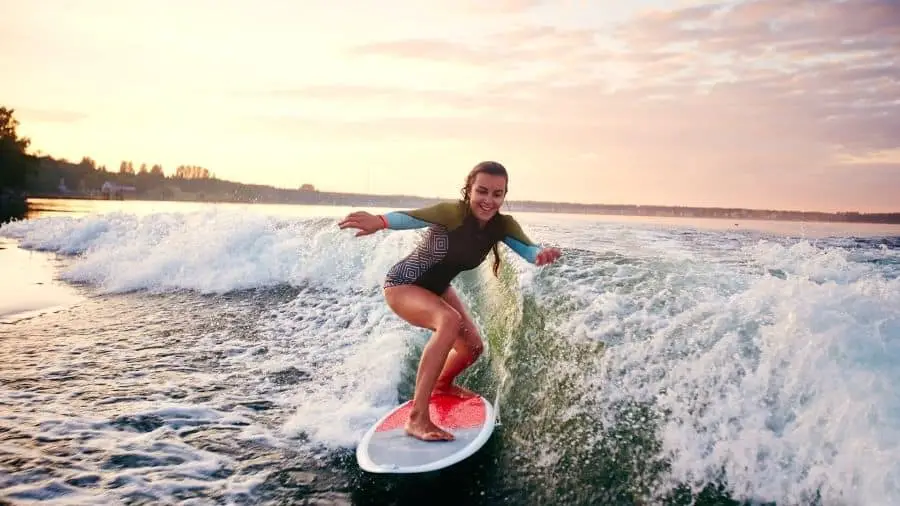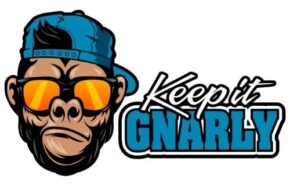
Learning how to surf can be one of the most rewarding experiences around. It can also be one of the most frustrating. This challenge in turn is what can make it so special. There are many different ways to learn to surf, and many different options of boards to learn to surf on.
Yes, a beginner can use a shortboard, however, it is not the optimal surfboard to learn on. Most beginners will struggle with a shortboard and it is recommended to start with a foam surfboard which is easier to paddle, catch waves, stand up on and is more buoyant.
Most beginner surfers start on a longboard or funboard, that is true. But it is possible to learn on a shortboard as well. We will go over the pros and cons of both and show some great options for each type of board as well.
Table of Contents
Pros and Cons of Learning to Surf on a Shortboard:
Learning how to surf should be a fun and challenging experience that never really ends. Are there ways to speed up the process or for that matter slow it down? Depending on who you talk to learning on a shortboard can do either.
Pros
The biggest pro that pops into my head of learning to surf on a shortboard is if you’re a child. I learned to surf on a shortboard when I was a child, and the majority of uber beginners on shortboards seem to be children too.
This is probably because effectively a shortboard to a small child is still rather large. It is massively helpful learning to surf at a young age and having years of a head start on the game. However, lots of my friends started later on in life so don’t let that put you off, you’re never too old to shred.
A shortboard is easy to get to and from the beach. If you’re a beginner at surfing you probably don’t live near the beach so this is huge. The easier it is for you to get down to the beach and go for a surf the more likely you’ll actually go surfing. And the more you go surfing the better you’ll get. Shortboards are easier to get to the beach because they are smaller so effectively can fit in almost any vehicle or easily under your arm whilst riding a bike.
Learning on a shortboard will skip an awkward transition phase. If you learn to surf on a shortboard you won’t have a weird time transitioning to a shorter board cause you’ll already know how to ride one. And that being said you’ll feel comfy on longboards as well. It’s like learning how to drive a manual car first. Yea maybe it’s harder at first but if you learn manual you learn automatic at the same time.
Cons
Harder. More difficult. There’s no way around it learning on a shortboard is tough. It takes more time and can be seen as more frustrating to learn to surf on a shortboard. Learning to surf is no easy task by any means, and learning on a shortboard doesn’t make it any easier.
More difficult/more effort to paddle. They are smaller and less buoyant so they are harder to paddle on then their longer brethren. Being harder to paddle is huge. As a beginner, you just don’t have those muscles yet so you’ll get tired much quicker on a shortboard because it will take more effort to paddle out.
Wave catching abilities. You want to try to get as many waves as you can when learning so you can get more time up riding. Shortboards just don’t catch waves as well as them big bois because they have much less volume. You have to be in a much more critical part of the wave to catch it and that takes much more experience to know where that part of the wave is, experience you don’t have because you’re still a newbie.
4 Tips for Learning on a Shortboard

Uno: The first tip I would give is don’t. You’ll make your life so much easier to just learn on a long foamie like everyone else in their right mind. Start out on the big bois then maybe after a month or two of consistent surfing start working your way down to smaller boards.
You’ll have much more fun and catch much more waves starting out on a good old fashioned funboard. But if your idea of fun is being exhausted, stuck inside and catching no waves by all means go for it.
Dos: Ok on to the second tiparoo. If you must learn on a shortboard, at least get one with some volume. Yes that 75 dollar potato chip on craigslist is tempting, but don’t be fooled by her sweet stickers and diamond-shaped nose guard, she’s a fickle mistress. Try to start out on something a little wider and thicker that will help you float out of the water more.
Tres: Thirdly, you’re going to want to make sure you are surfing as much as you can. This really goes for surfing on any type of board to be honest. Surfing is not like skiing, you can’t just go one weekend a year, and still be zipping around just fine drinking hot cocos with the boys.
But this is extra important when learning on a shortboard. You’re just going to need extra conditioning and strength that you might not have yet. 90 percent of learning to surf is catching waves. Hardest part really. And if you’re not strong enough to catch em you wont learn.
Thankfully the act of surfing itself is a kind of strength training. If you can’t get out and surf that much, do burpees at home.
Quatro: Choose where you surf accordingly. A few spots come to mind when I say this. Two in particular actually. Both are very popular with beginner surfers and both happen to be more of a longboard wave.
The first one is called sunset, in Malibu CA. Soooo good for learning. So many beginners come here. But it’s more of a longboard wave. That is a wave that is super slow breaking with not much power. Great for people on longboards who can catch slower waves because of that extra board volume.
But if you brought your shortboard here, even though it’s a beginner break, you wouldn’t have that much fun. Just would be really difficult to get into waves plus you’d have to compete with the long bois who can sit way deep and catch em way sooner.
The second spot is San O also southern California. Same story. But if you went to San O you’d have the option of going up the road and surfing at Trestles a world-famous wave for shortboards. So just think about where you’re guna surf and if a shortboard will work there.
What’s the Best Surfboard to Learn On?
8’0 foamie baby, the industry standard. Foamie means foam board. Foam boards are soft and cuddly all over because they are not fiberglassed. Instead, they are completely foam as the name implies. They are so popular for learning because if you get hit with one they don’t do that much damage.
8’0-10’0 being the most common size to learn on. The boards have a lot of volume and buoyancy making them great for people just starting out. They are wave magnets. Greedy little things who will catch a wave with the flick of a finger. I learned to surf years ago and still have so much fun on these things.
Probably the most common beginner board being the Wavestorm. They took off after Costco started selling em for 250 bucks, and now its almost impossible to go to the beach and not see someone with one.
They are great to learn on. Classic 8’0 foamie. And at a bargain for the price. Many surf schools use them for all of these reasons and they get results.
Even after you learn to surf or at least start to get better this will still be great to have. When the waves are small or generally crappy it will be a go-to muck around board that will ensure a good time in almost any conditions. Its always good to have a trusty foamie in the quiver for sure.
If you’re looking for something with a little more durability and quality and willing to spend the extra bucks Odysea Catch Surf makes awesome foam boards in all different sizes.
Their 8’0 log being very popular. A great board to learn on with endless possibilities for improvement if you’re interested in classic longboarding. You can easily start to step your game up on the log and begin exploring the art of walking the nose. The classic maneuver of hanging 10 where you hang all 10 toes off the nose of the board. And as an addition, they come in all sorts of awesome designs and colors.
What’s the Best Shortboard for Beginners?
Again, if you are just starting I would recommend a foam board. There are many options for foam shortboards on the market. I would also recommend something above the 6-foot mark as well. But smaller is ok too.
Odysea Catch Surf makes some really great shortboards as well. You’ll still be having a blast once your beginner days are done. They are thrusters, which means three fins. Being lightweight and able to take a beating is a huge plus. These boards will zip down the line all while being very forgiving if you happen to get hit in the face with it. With their bright colors and soft foam tops, they are perfect for kids all well.
Another option is NSP epoxy boards. They aren’t foam so you will have to be careful of head dingers, but they are a great step up or place to start. They are made of epoxy which is harder and more durable then fiberglass so they can endure all the bumps in the road that come along with learning to surf.
I would suggest the fun board size. A little larger than a shortboard, yes, but still by no means a longboard. The 6’7 or 7’0 is a great place to start. These boards still have the extra maneuverability of a shortboard with that added volume and buoyancy that’s so helpful when you’re starting out.
Choosing What Board to Surf
Whether you choose to start off on a shortboard or go the more traditional route of a funboard or longboard eventually your skills will develop and you’ll want to start branching out in new directions.
Choosing what to ride is a feeling one finds in their heart and soul. Make sure to check in with the ocean from time to time and feel what it’s telling you. Remember to go with the flow of the waves and the board you should be riding will come to you.
At the end of the day surfing is a pointless activity created for the sole reason of having. That’s it. Remember you’re meant to be having fun.
Learning to surf should be really fun. So if you take that shortie out and it’s not fun maybe switch it up. Or if you’re tired of lugging around a massive foamie try that epoxy shortie out for a change.
And remember, the worst case scenario is that you just played around in the ocean for a while which in my books is still a blast.
So grab whatever board you have or borrow one from a friend and go have a good time. Just don’t ride scooters. Ever. And don’t bring your kid to the skatepark if they ride a scooter.
